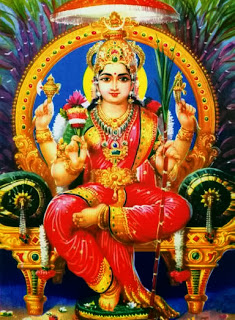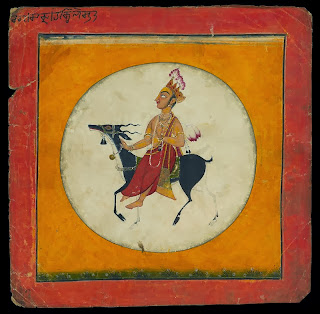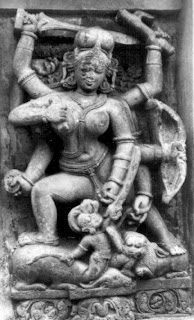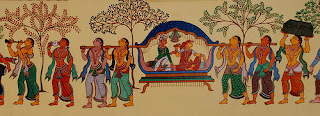Three Faces of Cosmos
The
cosmos revolved around Mount Mandara. On its peak sat Shiva in serene
meditation, unconcerned with the world, transcending samsara.
In
his hand was Brahma's skull, serving as his drinking-bowl. With it he
confronted the world, the body and the mind, with its mortality. He was
Kapalin, the skull-bearer.
Shiva
was glad to be out of the cycle of life.
Brahma
was not.
"If every creature on earth renounces the
world like Shiva, the universe will cease to exist. This must be stopped. But
how? " Brahma turned to Vishnu, the cosmic savior, for help.
"We
must get him a wife," replied Vishnu, "One who will bring him back
into the ways of the world.
"For
the survival of society the quest for moksha, spiritual liberation, must be
supplemented with the fulfillment of dharma, material duty.
"The
path of restraint, yoga must be balanced with the delights of pleasure, bhoga.
Together, Shiva with his consort will generate the middle path between
participation, bhukti and renunciation, mukti."
Brahma
agreed.
 Suddenly
the antagonism between Brahma and Shiva became clear to the gods Brahma was
rajasic, active and energetic while Shiva was tamasic, passive and inert. What
Brahma created srishthi, Shiva destroyed, samhara what Shiva destroyed, Brahma
recreated. The two justified each other's existence. While Brahma was
passionately involved in the creation of the world, Shiva was equally
dispassionate about it, preferring to transcend its wiles and become an
ascetic. Now that he had, it was time to recreate the cosmic tension by
seducing him back into the ways of the world.
Suddenly
the antagonism between Brahma and Shiva became clear to the gods Brahma was
rajasic, active and energetic while Shiva was tamasic, passive and inert. What
Brahma created srishthi, Shiva destroyed, samhara what Shiva destroyed, Brahma
recreated. The two justified each other's existence. While Brahma was
passionately involved in the creation of the world, Shiva was equally
dispassionate about it, preferring to transcend its wiles and become an
ascetic. Now that he had, it was time to recreate the cosmic tension by
seducing him back into the ways of the world.
Between
Shiva and Brahma stood Vishnu, the cosmic savior, always ensuring survival of
the prevailing order, sthithi. He was totally sattvic, constantly trying to
create a balance between the aggressiveness of the creator and the aggressiveness
of the destroyer.
"But
where will we find a woman who will match Shiva in spirit and strength?"
wondered Brahma. "I have already found one the mother-goddess
herself," said Vishnu.
"Yes,
yes. Who better than her! She is the personification of prakriti, embodiment of
Nature's elements and energies. But will she agree?"
"She
already has ... look, she has already taken birth in the house of the prajapati
Daksha as his youngest daughter, Sati."
Daksha's Daughter
 Daksha,
the prajapati, was the master of civilization, samaj. He formulated the rules
of society and ensured the survival of the traditional order. His daughters were
wives of the gods and their children had gone on to populate the whole world.
Daksha,
the prajapati, was the master of civilization, samaj. He formulated the rules
of society and ensured the survival of the traditional order. His daughters were
wives of the gods and their children had gone on to populate the whole world.
His
youngest child, Sati, was something very special, a manifestation of the
mother-goddess herself. She would make the perfect wife for Shiva, thought
Vishnu. Brahma agreed.
But
there was one problem Daksha himself.
Prajapati
Daksha never liked Shiva. Shiva was Ekavratya, an unorthodox hermit, who lived
by his own rules, not always acceptable to traditional society. He refused to
conform to the ways of the world. As guardian of civilization, Daksha found
that subversive.
"Shiva
wanders in cremation grounds with a rowdy bunch of renegades consuming
intoxicants that are forbidden in decent society. He sings and dances wherever
he wants to, with little heed to decorum and protocol. He has no home, no
possessions, no family, no vocation; he is a no good drifter, ritually impure,
unsuitable for any of my daughters, especially Sati," he said.
These
were of course excuses. There was a very simple reason why Daksha couldn't
stand Shiva: Shiva refused to indulge Daksha's ego.
Daksha
made the laws, defined codes of conduct, formulated the rules of society. He
naturally considered himself to be someone special, someone more important than
others. He expected everyone to bow before him. Shiva refused. He refused to
indulge any social rules that promoted pomposity in the name of respect.
Above
the bowed heads of the gods, Daksha saw Shiva. "He does not respect me;
nor does he disrespect me. It is as if I don't exist, that I don't
matter!" thought Daksha.
Daksha Curses the Moon
 Once,
Shiva saved the moon. By doing so, he incurred Daksha's wrath.
Once,
Shiva saved the moon. By doing so, he incurred Daksha's wrath.
Chandra,
the moon-god, had married twenty seven of Daksha's daughters the nakshatras,
lunar asterisms. But he preferred only one of them, the charming Rohini. He
ignored the rest, angering Daksha who cursed him, "May your radiant body,
of which you are so proud, wither away and disappear."
As
the curse took effect, Chandra became weak and dim. With each passing day his
lustre waned. Terrified, he went to the gods seeking a cure. But there was none
forthcoming. Vishnu suggested, "Go to Shiva. He is Somnath, keeper of the
sacred herb soma that might cure you."
Sure
enough Vaidyanath, the supreme physician, helped restore his lustre.
But
in time Daksha's accursed disease returned, once again gnawing into Chandra's
flesh. The moon-god ran to Shiva for help and again sought the magical soma.
Even this cure was followed by a relapse. This went on for some time curse
followed by cure followed by curse. Daksha's terrible malady wouldn't go away.
Finally Shiva said, "Come and stay within the locks of my hair. Here you
will find all the soma you need. Each time the disease troubles you, you can
rejuvenate yourself with my grace."
Shiva's
blessing went against Daksha's curse. While Daksha caused the moon to wane,
Shiva by placing the moon on his head helped it to wax again. Shiva, the
saviour of the moon, came to be known as Chandrashekhara. Thanks to him,
moonlight came to be filled with the magic of soma and the moon came to be
known as Soma.
 Daksha
considered Shiva's action an insult to his authority. He definitely did not
want this maverick for a son-in-law.
Daksha
considered Shiva's action an insult to his authority. He definitely did not
want this maverick for a son-in-law.
But
the matter was out of his hands. Sati was already in love with Shiva and had
made up her mind to marry him.
Shiva and Sati
"How
can I marry her?" cried Shiva, when Vishnu made the suggestion. "I
have renounced the world," he said. But he could not ignore the intensity
of Sati's love for him.
The
prajapati's daughter had abandoned the pleasures of society to be with him. She
lived like a hermit, alone, deep in the forest, surviving on fruits and roots,
performing terrible austerities, tapas, demanding an audience with the
hermit-lord.
"Why
do you want to marry me?" Shiva asked her.
"Because
you are incomplete without me and I am incomplete without you."
"But
I have nothing to offer you?"
"I
do not ask for anything, but you."
"I
have neither property nor a lineage, kula, nor do I desire any."
"I
accept you for what you are, not for what you have."
"I
only observe society; I do not participate in it."
"I
would like to observe it with you."
Sati's
determination impressed Shiva. He accepted her as his wife.
 Brahma
and Vishnu rejoiced. The circle of life was complete as Shiva became yet
another cog in the wheel of existence.
Brahma
and Vishnu rejoiced. The circle of life was complete as Shiva became yet
another cog in the wheel of existence.
Only
Daksha was unhappy.
Daksha's Great Sacrifice
Sati
walked out of Daksha's palace. She followed Shiva wherever he went: over lonely
hills, across desolate plains and dense forests, through cremation grounds. In
Shiva's company she did not miss her father or his home or his society.
Shiva
at first ignored Sati. He barely acknowledged her presence. Sati didn't mind.
She followed him selflessly, content to be by his side. Her fortitude and
patience, her serene determination to be his consort, her giving nature and
radiant personality everything about her pleased Shiva. He fell in love.
Daksha
meanwhile organized a great yagna.
Everyone
was invited except Shiva.
"I
think it is an oversight. Let's go anyway," said Sati.
"No
Sati, don't be an uninvited guest."
Sati Kills Herself
 "I
will go to my father's house, with or without you, whether you like it or
not," said Sati firmly.
"I
will go to my father's house, with or without you, whether you like it or
not," said Sati firmly.
Dressed
in her finest robes with a garland of lotuses round her neck, Shiva's
headstrong wife went to Daksha's yagna. She walked right into the sacrificial
hall. Around the sacred fire sat all the gods, the sages, deities from every
plane of existence. None rose to greet her. To her surprise, even her father
did not seem particularly pleased to see her.
"You
weren't invited. Why did you come? Have you had enough of your vagabond
husband?" Daksha asked. His words hit Sati like poisoned barbs. The
assembled gods and sages chose to ignore Daksha's remarks. Unlike them, Sati
stood up for Shiva. "My husband is no vagabond. He is a yogi, aware of the
ways of the cosmos."
Surprised
by his daughter's retort, Daksha said, "If he is such a wise man, how come
he does not know the basic rules of society. Look at the way he lives, the
clothes he wears, the company he keeps."
 "Society
is an artificial creation of man. My lord is one with Nature, he is lord of the
plants, lord of the beasts."
"Society
is an artificial creation of man. My lord is one with Nature, he is lord of the
plants, lord of the beasts."
"Lord
of the beasts! He is a beast himself: no home, no family, no decency, no decorum.
I am ashamed to introduce him as my daughter's husband." The gods laughed.
Sati wept.
Suddenly
it all became clear; Sati realized that the sacrifice was an elaborate ritual
aimed at insulting her lord. The humiliation was too much to bear. Death seemed
a better alternative to the shame.
Sati
sat on the ground, her mind fixed on Shiva. She controlled her breath and
stoked her inner fire, prana-agni, until it consumed her.
The
fire she created is the dreaded Jwala-mukhi that is now found in Himachal Pradesh.
Shiva loses his Temper
News
of Sati's death shocked Shiva. Then came the pain.
 Shiva
experienced the pangs of separation viraha, the anguish of loneliness. From
that suffering, dukkha, came anger, krodha. With the anger came the monsters of
fever: the germs that inflame the body and fill it with purulent fluids. Shiva
became Jvareshvara, lord of fevers. His indignation contorted his features and
turned him into the savage Virupaksha, the malignant-eyed.
Shiva
experienced the pangs of separation viraha, the anguish of loneliness. From
that suffering, dukkha, came anger, krodha. With the anger came the monsters of
fever: the germs that inflame the body and fill it with purulent fluids. Shiva
became Jvareshvara, lord of fevers. His indignation contorted his features and
turned him into the savage Virupaksha, the malignant-eyed.
Shiva
plucked out his hair and lashed it on the ground to create the grim Virabhadra
and the fierce Bhadrakali. "Go ravish the sacrifice violate the fire,
poison the waters, pollute the air and kill the gods. They deprived me of Sati,
let them be deprived of their lives," ordered Shiva.
Virabhadra
picked up his trident and summoned an army, a cackling horde of ghosts,
goblins, ghouls, genii, monsters, demons, dragons, freaks, fiends and spirits the
ganas of Shiva. They marched towards Daksha's sacrificial halls cheered by the
shrill cries of Bhadrakali.
Evil
omens had begun to appear at Daksha's palace. Vultures circled above the
sacrificial altar, wolves howled.
Fear
arose in the very heart of the cosmos.
Destruction of the Sacrifice
A
hundred thousand rabid dogs rushed into Daksha's precinct carrying on their
backs the monsters of fever. These fiends leapt on the gods and struck them
with such fury that they all began to convulse and vomit blood.
Then
with a virulent war-cry Virabhadra and his savage entourage descended on the
scene. They wrecked the place: sacred vessels were kicked, tapestries were
ripped and pavilions burnt.
As
the gods took flight, the demons seized and massacred them all... Bhadrakali
drank their blood.
The
sage Bhrigu used his magical powers and tried to conjure up spirits who would
save the
sacrifice. But the spirits refused to emerge when they heard
Bhadrakali howl. Those that did were dismembered by Shiva's gams.
Finally
Bhadrakali dragged Daksha by his feet towards the fire-altar. Virabhadra raised
his axe and beheaded the prajapati. The severed head was tossed into the
flames.
Then,
Virabhadra laughed and Bhadrakali danced. She used the heads of the gods as
beads for her garland while he decorated his body with their entrails. The
ganas joined in the gory revelry. The sacrificial hall was now claimed by
Shiva. He became known as Hara, the ravisher.
With
that, Shiva's fury subsided. Only the sorrow remained.
Shiva forgives Daksha
Shiva
walked into Daksha's sacrificial hall and was confronted with the aftermath of
the bloodbath a feast for wolves, vultures and vampires. He was filled with
pity, karuna.
The
survivors of the carnage fell at his feet and begged for mercy. He smiled.
Instantly a fragrant breeze swept across the scene. The fevers subsided. The
dead gods arose as if waking from a deep slumber. Their wounds had healed, the
broken bones had been mended, the missing limbs restored.
Shiva
found Daksha's headless body and brought it back to life, replacing his head
with that of a goat.
Shiva
then gave him the city of Bhogya, "This is a city of uninhibited pleasure.
I created it for Sati. Here I indulged in every pleasure imaginable and became
a bhogi. But now Sati is no more. I have no use for Bhogya. I gift it to
you."
Daksha
was overwhelmed by Shiva's generosity. The goat headed prajapati began to sing
Shiva's praises. "You are Shankar, the benevolent one, a kind god,"
he said. Daksha completed his sacrifice. This time he gave Shiva his rightful
share. Shiva ceased being a rejected god, an outsider. He was accepted, adored,
held in awe. He became part of the celestial pantheon.
Only
Sati was dead.
Sati's Corpse is Destroyed
 Shiva
picked up Sati's lifeless body and walked out of the sacrificial hall. He could
not bring himself to cremate it. The body was all that he had to remind him of
his beloved. He refused to part with it.
Shiva
picked up Sati's lifeless body and walked out of the sacrificial hall. He could
not bring himself to cremate it. The body was all that he had to remind him of
his beloved. He refused to part with it.
Distraught,
he wandered across the cosmos with Sati's corpse in his arms, tears rolling
down his cheeks. His ganas followed him silently, not knowing how to console
their lord. His mournful cry rent the galaxies and stunned the gods. "This
must stop," said Brahma, "Otherwise the whole cosmos will be
submerged by Shiva's agony."
Vishnu
raised his finger to spin his mighty discus, sudarshan chakra, and let it fly.
Its sharp edges ripped Sati's corpse into 108 pieces. These fell in different
parts of Jambudvipa, the rose apple continent of India, and became
shaktipithas, the shrines of Sati.
With
the body gone, there was nothing left to remind Shiva of Sati, except memories.
And memories fade.
Sati
had taught Shiva all about pleasure, Kama. Her departure had taught him about
anger, krodha. Together Kama-krodha trap man in samsara.
Shiva
had had enough of life. He isolated himself in the icy caves of the Himalayas.
He became a recluse once more.
The
mother-goddess, embodiment of all matter, is never stable. She is constantly in
a state of flux. Her death was just a transformation; Sati would return in
another form. The gods knew that. Shiva did too.
Writer Name:- Devdutt Pattanaik
Read Also:
 Suddenly
the antagonism between Brahma and Shiva became clear to the gods Brahma was
rajasic, active and energetic while Shiva was tamasic, passive and inert. What
Brahma created srishthi, Shiva destroyed, samhara what Shiva destroyed, Brahma
recreated. The two justified each other's existence. While Brahma was
passionately involved in the creation of the world, Shiva was equally
dispassionate about it, preferring to transcend its wiles and become an
ascetic. Now that he had, it was time to recreate the cosmic tension by
seducing him back into the ways of the world.
Suddenly
the antagonism between Brahma and Shiva became clear to the gods Brahma was
rajasic, active and energetic while Shiva was tamasic, passive and inert. What
Brahma created srishthi, Shiva destroyed, samhara what Shiva destroyed, Brahma
recreated. The two justified each other's existence. While Brahma was
passionately involved in the creation of the world, Shiva was equally
dispassionate about it, preferring to transcend its wiles and become an
ascetic. Now that he had, it was time to recreate the cosmic tension by
seducing him back into the ways of the world.  Daksha,
the prajapati, was the master of civilization, samaj. He formulated the rules
of society and ensured the survival of the traditional order. His daughters were
wives of the gods and their children had gone on to populate the whole world.
Daksha,
the prajapati, was the master of civilization, samaj. He formulated the rules
of society and ensured the survival of the traditional order. His daughters were
wives of the gods and their children had gone on to populate the whole world.  Daksha
considered Shiva's action an insult to his authority. He definitely did not
want this maverick for a son-in-law.
Daksha
considered Shiva's action an insult to his authority. He definitely did not
want this maverick for a son-in-law.  Brahma
and Vishnu rejoiced. The circle of life was complete as Shiva became yet
another cog in the wheel of existence.
Brahma
and Vishnu rejoiced. The circle of life was complete as Shiva became yet
another cog in the wheel of existence.  "I
will go to my father's house, with or without you, whether you like it or
not," said Sati firmly.
"I
will go to my father's house, with or without you, whether you like it or
not," said Sati firmly.  "Society
is an artificial creation of man. My lord is one with Nature, he is lord of the
plants, lord of the beasts."
"Society
is an artificial creation of man. My lord is one with Nature, he is lord of the
plants, lord of the beasts."  Shiva
experienced the pangs of separation viraha, the anguish of loneliness. From
that suffering, dukkha, came anger, krodha. With the anger came the monsters of
fever: the germs that inflame the body and fill it with purulent fluids. Shiva
became Jvareshvara, lord of fevers. His indignation contorted his features and
turned him into the savage Virupaksha, the malignant-eyed.
Shiva
experienced the pangs of separation viraha, the anguish of loneliness. From
that suffering, dukkha, came anger, krodha. With the anger came the monsters of
fever: the germs that inflame the body and fill it with purulent fluids. Shiva
became Jvareshvara, lord of fevers. His indignation contorted his features and
turned him into the savage Virupaksha, the malignant-eyed.  Shiva
picked up Sati's lifeless body and walked out of the sacrificial hall. He could
not bring himself to cremate it. The body was all that he had to remind him of
his beloved. He refused to part with it.
Shiva
picked up Sati's lifeless body and walked out of the sacrificial hall. He could
not bring himself to cremate it. The body was all that he had to remind him of
his beloved. He refused to part with it. 














0 Response to "Marriage of Shiva "
Post a Comment